Teaching in Honor-Shame Cultures: 5 Must Knows
In 2001 I taught American literature at a university in Central Asia. It was my first year living overseas, and the experience of teaching cross-culturally caused many instances of culture shock.
I enjoyed the friendships with students, but I resented their ongoing attempts to honor me as a teacher. They always stood when I entered the room, called me “Dr. Professor,” and declined to answer my questions—these are all gestures of respect, but I didn’t receive them well! I was a typical young guy from California; my wardrobe was t-shirts, shorts, and sandals. But in Central Asian culture, teachers’ clothing should reflect their social importance—this means a three-piece suit, even in July. I begrudged these Central Asian habits of “social maintenance” in the classroom.
 These small examples of culture shock are normal when teaching cross-culturally. With time, a better cultural understanding improved my relationships with students and increased my enjoyment of teaching. Here are five examples to help you understand and educate students.
These small examples of culture shock are normal when teaching cross-culturally. With time, a better cultural understanding improved my relationships with students and increased my enjoyment of teaching. Here are five examples to help you understand and educate students.
-
Education is for reputation.
In honor-shame cultures, people study to acquire status, not just information. Education is one of the best ways to “gain face.” People boast about their educational degrees, and parents gain prominence from their children’s academic achievements. The motive for many students (and their families) is to enhance reputation. This explains some of the pressure to attend prestigious schools.
-
Teachers are revered.
In honor-shame cultures, teachers are near the top of the social hierarchy. A Central Asian friend told me her childhood memory—she was dismayed to see her teacher exit the school bathroom, because she assumed teachers were so holy they never had to relieve themselves!
Students communicate honor to teachers. They may use special titles, perform honorific gestures (i.e. standing up, shaking hands), and give token gifts. These actions are meant to strengthen the relationship, which helps them procure the teacher’s knowledge and wisdom. Similarly, they always avoid shaming teachers. Students ask few questions to avoid disrespecting or challenging the teacher. And soliciting “constructive feedback” is difficult when students seek to “give face.” Western teachers disregard social distance and prefer a more egalitarian relationship with students. But this tendency discomforts non-Western students who seek to “know their place” and honor the teacher.
-
Students are from honorable families.
Most international students in the West come from a family with money or connections. They’ve grown accustomed to being treated as higher class, or “the golden child.” This does not excuse a student’s snobbery or arrogance, but can help you counsel students struggling with a loss of identity or status in their own enculturation process.
-
Learning happens collectively.
In group-oriented cultures, most of life depends on whom you know, not what you know. Problems are solved via connections and relationships. In a classroom environment, this means school assignments are not measures of individual knowledge, but opportunities for group collaboration. So during tests, students feel free to work together on answers. For them, this is “helping,” not “cheating.”
-
Enjoy food together.
In many cultures, sharing food symbolizes relationships. To get to know your students, eat with them. Join them for a meal in the cafeteria. Invite your students to your house. Ask them to join you at a restaurant with their cultural cuisine. When my wife taught English as a Second Language (ESL) in Los Angeles, our fondest memories were the times when we had students in our home. Students will feel honored when you take time to break bread with them.
Conclusion
Teaching cross-culturally can evoke confusion, frustration, and shock. Christian educators must discern how cultural differences impact education. Understanding the honor-shame paradigm can help us relate to students around the world, both inside and outside the classroom.
This post is excerpted from an article published at Christian Educator’s Journal.

These 5 points you listed for teachers to be aware of in working with honor-shame cultural students are very valuable and essential to be an effective teacher. You have the personal experience in teaching in such a culture, so the 5 points you listed are very meaningful. Thank you for sharing them.
I’m a public school teacher and had an encounter with a student this week that I talked about on my Facebook page https://www.facebook.com/compellinginput/. Having read the post on teaching in Honor-Shame cultures, I reflected on what happened in our interaction and how the concept of honor applied to our dealings with one another. It was all positive because I honored my student, and he showed me honor in return. I would love to get some feedback on the article.
I totally agree, Ithought that I was being over ambitious, but when l read your honor/shame article l realized that l was not wrong. Sometimes being a student is not easy because of the way that your that your teacher receive you.